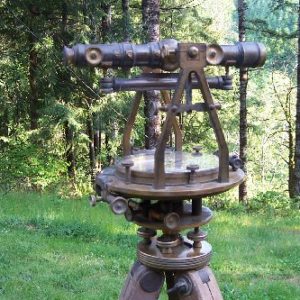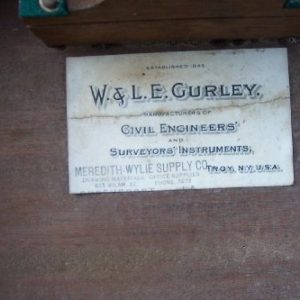I’ve been doing some foundation work on a new home…lots of corners, steps, etc. I’ve been renting a transit.
One of my employees told me Friday, “I’ve got a transit…no need to rent one….I think mine works, but I’m not sure.”
So I envision a beat up cheap Monkey Wards from a garage sale.
Today, he shows up with it. It works perfectly. I’ve already traded him out of it!
(Circa 1910)





















Replies
Great find,
always kick myself I didn't latch onto the Dietzen transit I saw at a state surplus sale for $50 in 1980.
Notchman: It's amazing what can walk into ones life unexpectedly. Not wanting to be nosey, but curious, what did you trade?
Rugby
Believe it or not, I traded a Dietzen optical machine level, circa 1940's, accurate to within .005" at 100 ft. (I have two). I've used both of them for building layout and they're overkill, but accurate and really nice tools. (We used them in sawmills for setting "V" rails for oldgrowth headrig log carriages).
The guy I'm trading with hasn't a clue about using a transit (and I'm not going to teach him...for awhile anyway). He's happy with the level.
And I like 4 post adjustments. The K&E rental I was using was a 3 post with two adjusting screws, which I've always hated.
Junkhound: I was thinking of you as soon as I set eyes on the transit! (Maybe we'll have a chat about my other machine level).
Where is the vertical circle?
~PeterView Image
This actually a surveying transit where the need then was for horizontal level and angles.
notch... i cut my teeth on a Wilde T-2 ....artillery surveying..
since those days, just a K&E builder's transit.. most of the time we use our laser..
but that brass beauty of yours is a real prize... what does the case look like?Mike Smith Rhode Island : Design / Build / Repair / Restore
The wood case is in fairly decent shape. Hinge side is broken, but repairable. Everything is still in the box, including a little tube of graphite grease.
Nice gun. Used similar K&E's for surveying. These guns have several adjustments that need to be checked periodically for accuracy. The plate levels and the barrel level need to be in agreement. The "flop" on the scope needs to be checked if you are doing much work producing lines behind you.
Set it up on a point, sight another point 100' away, flop the scope, set a stake with a tack in it exactly on line, loosen the lower motion, rotate it 180 degrees, sight the original point, flop the scope back and see if you hit the second point you set. If not, use the small brass vertical crosshair adjuster, and take out 1/2 of the error. Try it again till you split the point on the flop and turn.
Check the level by leveling up the bottom plate and the scope bubble, shoot your rod, record the reading, turn 180 degrees, shoot your rod again, record that reading, break your set-up and set up again, shoot the second point, then the first again. The difference between the two readings should be the same. If not, use the horizontal adjustment to move the cross hair a fuzz and try it again till the readings match. You might want to set up a bench mark system at your home with points that are set up permanantly so you don't have to do it on the job.
Headrig set-ups?
Who'd you work for, I worked for CAE Machinery,Nicholson Mfg., Durand/Raute.....wow, lots of parallels....If it is to be.... 'twil be done by me.
Hope this doesn't sound like a foolish question but ............ what about wearing glasses (or not) when using a transit; does it affect the accuracy of your work? These old eyeballs ain't what they used to be.
I have to use reading glasses to read the vernier scales, but no glasses for the telescope.
I've worn glasses all of my life,and ran all kinds of levels, transits, and theatolites for 30+ years and never had any problem. The plastic lenses on glasses tend to get scratched from the eyepieces of the older guns, but the newer ones have soft eyepieces.
Your field of view is cut down some, but not significantly.
If you have an old transit, like a K&E 20 minute gun, you definitely need a small magnifing glass to read the minutes and seconds on the vernier. The new ones have LCD readouts.
Worked for Weyerhaeuser Co....maintenance, mostly OG sawmills.
I've worked on a few Nicholson debarkers...our headrigs were mostly Filer and Stowell with steam shotguns on the carriages, although the last mill I worked in had a "Speedy Twin" steam engine to turn the drum for the carriage cables...That carriage weighed over 60 tons without a log on it, and that old steam engine ran for nearly 40 years with no major work done to it....It's currently in a museum in Chemult, Oregon, I believe.
Edited 6/3/2003 10:07:02 PM ET by Notchman
Thanks for the great information. You should write instruction manuals...no kidding!
I found a website...American tools and technology, that described the instrument I have along with others...I'll dig out the site for another post, because it has a lot of good stuff in it.
But their description of the transit didn't hold a candle to yours!
I know nothing about tranists, but that thing is pure beauty.
Congrats.
Never be afraid to try something new. Remember, amateurs built the ark, Professionals build the Titanic.